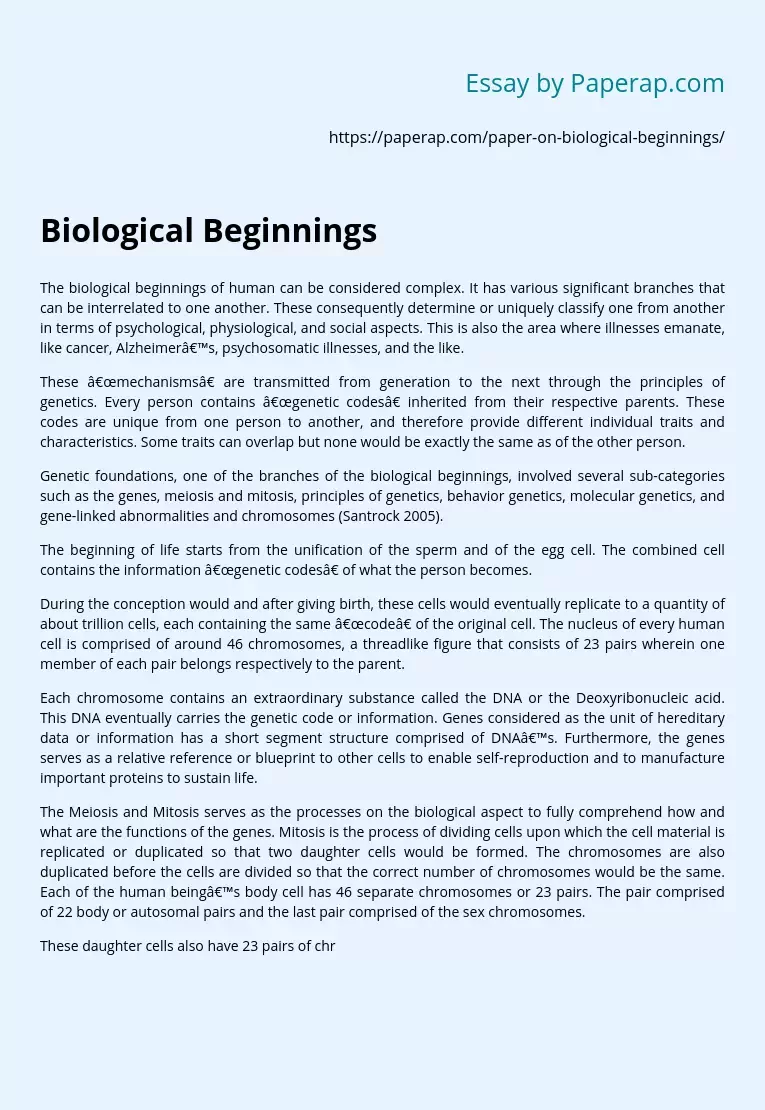Biological Beginnings of Human
The biological beginnings of human can be considered complex. It has various significant branches that can be interrelated to one another. These consequently determine or uniquely classify one from another in terms of psychological, physiological, and social aspects. This is also the area where illnesses emanate, like cancer, Alzheimer’s, psychosomatic illnesses, and the like.
These “mechanisms” are transmitted from generation to the next through the principles of genetics. Every person contains “genetic codes” inherited from their respective parents. These codes are unique from one person to another, and therefore provide different individual traits and characteristics.
Some traits can overlap but none would be exactly the same as of the other person.
Genetic foundations, one of the branches of the biological beginnings, involved several sub-categories such as the genes, meiosis and mitosis, principles of genetics, behavior genetics, molecular genetics, and gene-linked abnormalities and chromosomes (Santrock 2005).
The beginning of life starts from the unification of the sperm and of the egg cell.
The combined cell contains the information “genetic codes” of what the person becomes.
During the conception would and after giving birth, these cells would eventually replicate to a quantity of about trillion cells, each containing the same “code” of the original cell. The nucleus of every human cell is comprised of around 46 chromosomes, a threadlike figure that consists of 23 pairs wherein one member of each pair belongs respectively to the parent.
Each chromosome contains an extraordinary substance called the DNA or the Deoxyribonucleic acid. This DNA eventually carries the genetic code or information.
Genes considered as the unit of hereditary data or information has a short segment structure comprised of DNA’s. Furthermore, the genes serves as a relative reference or blueprint to other cells to enable self-reproduction and to manufacture important proteins to sustain life.
The Meiosis and Mitosis serves as the processes on the biological aspect to fully comprehend how and what are the functions of the genes. Mitosis is the process of dividing cells upon which the cell material is replicated or duplicated so that two daughter cells would be formed. The chromosomes are also duplicated before the cells are divided so that the correct number of chromosomes would be the same. Each of the human being’s body cell has 46 separate chromosomes or 23 pairs. The pair comprised of 22 body or autosomal pairs and the last pair comprised of the sex chromosomes.
These daughter cells also have 23 pairs of chromosomes similar to the original cell. In Meiosis, the sex cells are divided into two, thus producing 4 daughter cells. It is the process of reducing the number of chromosomes in a sex cell to half of the original quantity.
The reduction division is one phase of the Meiosis process and when completed each cell produced contains 23 chromosomes, upon which these will eventually be contributed to the zygote for a total of 23 pairs of chromosomes or 46 individual chromosomes. The zygote is the single cell formed when the ovum is fertilized by the sperm cell, the reproduction process. This zygote contains 23 pairs of chromosomes or 46 individual chromosomes.
There are several genetic principles that have been discovered such as the sex-linked genes, the dominant and recessive genes, the inherited polygenically characteristics, canalization, and reaction range. The sex-linked genes refer to the existence of two sex cells out of the 46 chromosomes in a human being.
Discovered in 1920, the female has two X chromosomes while the male has an X and Y-chromosomes. This will consequently determine the resulting sex of the new born. The dominant-recessive genes principle described the relevant behavior of two genes; the dominant gene usually overrides the recessive gene.
The recessive gene exerts its power if both genes are recessive. The traits or characteristics being carried by the dominant gene (brown eyes, dimples, etc.) would be passed on to the child if the combined genes are dominant-recessive type. The Polygenic inheritance is the principle in genetics wherein the genes combines to form or produce a specific characteristic. Only a few psychological traits are formed from single cell, the rest are the results of the interaction of different genes from one another.
Biological Beginnings of Human. (2018, Aug 11). Retrieved from https://paperap.com/paper-on-biological-beginnings/

